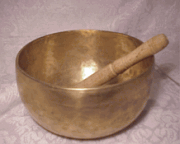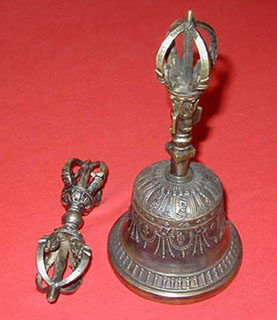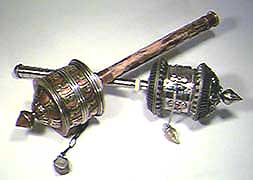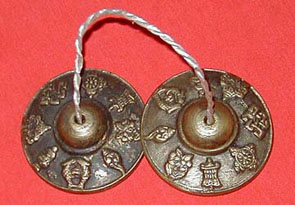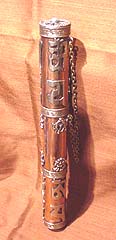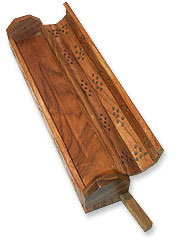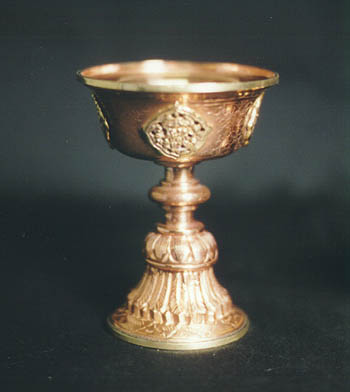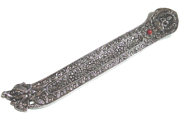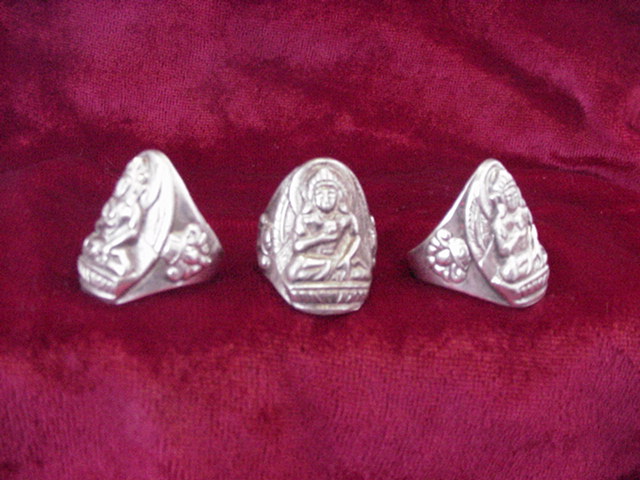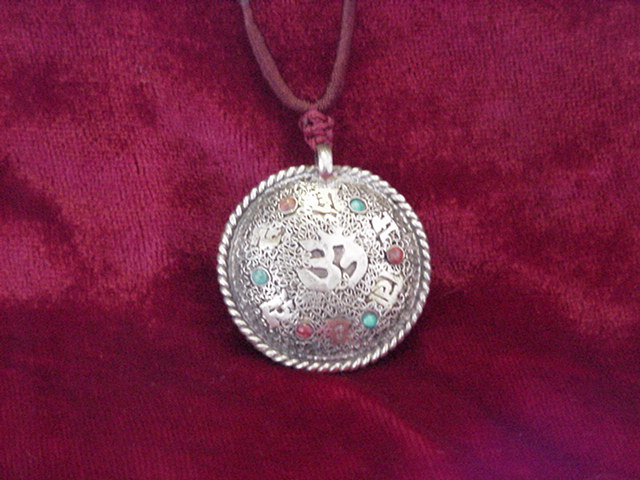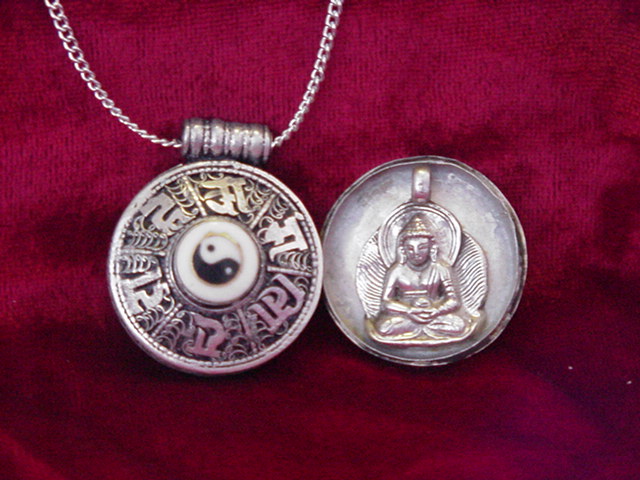The eight auspicious symbols of Tibetan Buddhism consist of: parasol,
pair of fishes, treasure vase, lotus, white-spiralling conch shell, endless
knot, victory banner, and golden wheel.Groupings of eight auspicious symbols
were originally used in India at ceremonies such as an investiture or coronation
of a king. An early grouping of symbols included: throne, swastika, handprint,
hooked knot, vase of jewels, water libation flask, pair of fishes, lidded
bowl.In Buddhism, these eight symbols of good fortune represent the offerings
made by the gods to Shakyamuni Buddha immediately after he gained enlightenment.
from top left to bottom right:
The Parasol (umbrella):
This was a traditional Indian symbol of protection and royalty. The parasol
denoted wealth and status - the more carried in a person's entourage,
the more influential the person was; 13 parasols defining the status of
king. This concept was adopted by Indian Buddhists who saw the Buddha
as the universal monarch and 13 stacked parasols form the conical spire
of the Buddha or Tathagata stupa. In Buddhist mythology, a jewelled umbrella
is said to have been given to the Buddha by the king of the nagas .
Symbolically, the protection provided by the parasol is from the heat
of suffering, desire, obstacles, illness and harmful forces.
A typical Tibetan parasol consists of a thin round wooden frame with
8,16 or 32 thin arched wooden spokes. Through its centre passes a long
wooden axle-pole embellished at its top with a metal lotus, vase and jewel
filial. Over the domed frame is stretched white, yellow or multicoloured
silk and from the circular frame hangs a folded or pleated silk skirt
with 8 or 16 hanging silk pendants attached. The parasol dome represents
wisdom and the hanging skirt, compassion.
The Two Golden Fishes: The two fishes originally represented the two
main sacred rivers of India - the Ganges and Yamuna. These rivers are
associated with the lunar and solar channels which originate in the nostrils
and carry the alternating rhythms of breath or prana. They have religious
significance in Hindu, Jain and Buddhist traditions but also in Christianity
(the sign of the fish, the feeding of the five thousand). In Buddhism,
the fish symbolise happiness as they have complete freedom of movement
in the water. They represent fertility and abundance. Often drawn in the
form of carp which are regarded in the Orient as sacred on account of
their elegant beauty, size and life-span.
The Treasure Vase:This is known as 'the vase of inexhaustible treasures'
- however much is removed from it, the vase remains perpetually full.
In Tibet, wealth vases sealed with precious and sacred substances are
commonly placed upon altars and on mountain passes, or buried at water
springs. The symbol is often shown as a highly ornate, traditional-shaped
vase with a flaming jewel or jewels protruding from its mouth.
The Lotus Flower:The lotus blossoms unstained from the watery mire; it
is a symbol of purity, renunciation and divinity.
The Right-Spiralling Conch Shell:
The conch shell is thought to have been the original horn-trumpet; ancient
Indian mythical epics relate heroes carrying conch shells. The Indian
god Vishnu is also described as having a conch shell as one of his main
emblems; his shell bore the name Panchajanya meaning 'having control over
the five classes of beings'.
The conch shell is an emblem of power, authority and sovereignty; its
blast is believed to banish evil spirits, avert natural disasters, and
scare away poisonous creatures. In Indian culture, different types of
conch shell were associated with the different castes and with male and
female.
In Buddhism, the conch was adopted as a symbol of religious sovereignty
and an emblem which fearlessly proclaimed the truth of the dharma. One
of the 32 signs of a Buddha's body is his deep and resonant voice, which
is artistically symbolised in images of the Buddha by three conch-like
curving lines on his throat.
Shells which spiral to the right are very rare and considered especially
sacred, the right spiral mirroring the motion of the sun, moon, planets
and stars across the sky. Also, the hair whorls on Buddha's head spiral
to the right, as do his fine bodily hairs, the long white curl between
his eyebrows and the conch like swirl of his navel. A shell is made into
Tibetan ritual musical instruments by cutting off the end of its tip and
furnishing it with a mouthpiece and an ornamental metal casing extending
from the shell's mouth.
The Endless Knot:
This symbol was originally associated with Vishnu and represented his
devotion for his consort Lakshmi, the goddess of wealth and good fortune.
It symbolises the Buddha's endless wisdom and compassion. It also can
represent continuity or dependent origination as the underlying reality
of existence.
The Victory Banner:
These were traditionally carried in battle. Great warriors would often
have banners with their own emblems, the banners being carried on the
back of their chariots. Krishna (an incarnation of Vishnu) had a banner
bearing the garuda bird. In early Buddhism, the banner represented Buddha's
victorious enlightenment with his overcoming the armies of Mara (hindrances
and defilements). The banner is said to have been placed on the summit
of Mt Meru, symbolising Buddha's victory over the entire universe. In
Tibetan buddhism, the banner represents eleven methods of overcoming Mara:
the development of knowledge, wisdom, compassion, meditation and ethical
vows; taking refuge in the Buddha,; abandoning false views,; generating
spiritual aspiration, skilful means and selflessness; and the unity of
the three samadhis of emptiness, formlessness and desirelessness.
The Golden Wheel: The wheel is an ancient Indian symbol of creation,
sovereignty, protection, and the sun. The six-spoked wheel was associated
with Vishnu and was know as the Sudarshana Chakra. The wheel represents
motion, continuity and change, forever moving onwards like the circular
wheel of the heavens.
Buddhism adopted the wheel as a symbol of the Buddha's teachings and
his first discourse at the Deer Park in Sarnath is known as 'the first
turning of the wheel of dharma'. In Tibetan Buddhism, it is understood
as 'the wheel of transformation' or spiritual change. The hub of the wheel
symbolises moral discipline, the eight spokes represent analytical insight,
the rim - meditative concentration. The eight spokes point to the eight
directions and symbolise the Buddha's Noble Eightfold Path: right understanding,
right thought, right speech, right action, right livelihood, right effort,
mindfulness and concentration
|
